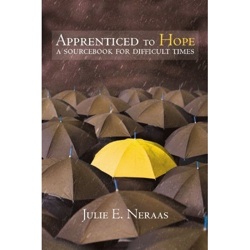
Awhile back Anthony Scioli, coauthor of “Hope in the Age of Anxiety” discussed nine forms of hopelessness and how you can overcome them. This week, I’ve invited Julie Neraas, author of “Apprenticed to Hope: A Sourcebook for Difficult Times,” to tell us about the different kinds of hope. Julie is an ordained minister, spiritual director and associate professor at Hamline University, and speaks regularly about hope, where it can guide you, how it can sustain you, and what meaning it can bring to your life. For more information visit www.julieneraas.com. Here’s Julie …
Not all hopes are alike. There are many different kinds like daily hopes – that rain won’t spoil the picnic, that the dentist will not find cavities. Or still larger hopes, for example that our children will be healthy and happy or that we will emerge from the recession and find adequate work. Or even more substantial hopes for a cure for cancer, for the wellbeing of our planet.
Here are still more kinds of hope. Remember most hope is good – it’s just important to understand there are different flavors of it!
1. Inborn Hope – Most children have hope, it’s their basic disposition unless adults do something to threaten it. Some people have to struggle for their hope while others seem to have it so easily. It depends on disposition.
2. Chosen Hope – This is the person with cancer who determinedly chooses to believe that treatment will be successful no matter the current outlook. It’s a parent’s right to hope for a child, even if things don’t look good at the mo-ment. Chosen hope is a life stance.
3. Borrowed Hope – Sometimes another person sees causes for hope in your life more easily than you can. If the person is honest and trustworthy, you can borrow their confidence in you, and their hope for you.
4. Bargainer’s Hope – When a daunting challenge or crisis crashes into our life, we can take a bargainer’s position. This position says, “If I do this, then that will happen,” There’s nothing wrong with bargainer’s hope, it’s human nature and often a first response to something really hard.
5. Unrealistic Hope – This kind of hope belongs to teenagers who believe they could be the next Michael Jordan of basketball. Or the hope created by the promise of a certain cereal will help you lose weight and keep it off for years to come. You’re hoping for things that could happen, but it’s not probable.
6. False Hope – There are silly versions of false hope, like chain letters promising money if you send them along. Or more serious false hopes, like the ones created by nasty insurance schemes that bilk money from people. And everyday examples of false hope, such as the hope that one person, whether friend or spouse, can meet all your needs and make you happy.
7. Mature Hope – A person with this kind of hope can wait. His or her hope is not based on particular outcomes or on a belief that everything will turn out well. Mature hope is based on meaning. In other words, things are worthwhile regardless of how they turn out.
Martin Luther King Jr., took the long view when he said, “The long arm of history bends toward justice.” Mature hope is a hope that jumps in to participate in the desired outcome. It doesn’t give up easily and it can be the most fulfilling.
What kind of hope do you have?
* Click here to subscribe to Beyond Blue! And click here to follow Therese on Twitter. And click here to join Group Beyond Blue, a depression support group. Now stop clicking.

